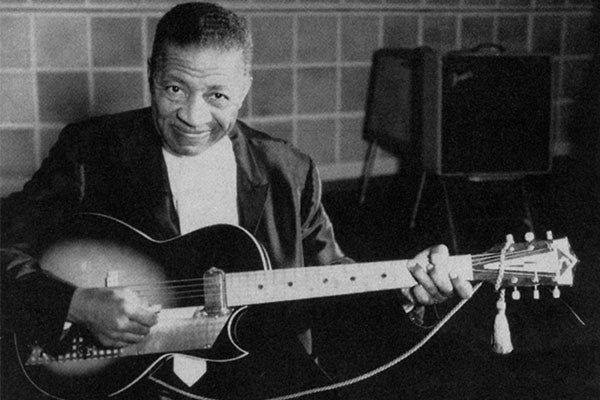Lonnie Johnson – A Complete Biography
Introduction
Lonnie Johnson stands at the crossroads of blues and jazz, the rare musician whose single-string guitar leads redefined how both traditions could sound. A refined singer, an expressive lyricist, and a multi-instrumentalist who also played violin and piano, he helped move the guitar from a purely rhythmic role to a frontline, improvising voice. From early fame in the 1920s to a mid-century fade and a late-life revival, Johnson’s journey traces the changing fortunes of American roots music across the 20th century.

Childhood
Alonzo “Lonnie” Johnson was born into a large, musical family in New Orleans—often cited as February 8, 1899, though sources disagree on the precise year. His father led a string band, and Lonnie grew up around instruments, studying violin, piano, and guitar and soaking in the city’s mix of ragtime, jazz, vaudeville, and blues. As a teenager he played in Storyville’s brothels and cabarets, learning to tailor his sound for dancers and late-night audiences.
Youth
In 1917, Johnson joined a revue that toured England and continental Europe; when he returned around 1919, the Spanish influenza pandemic had devastated his family, leaving only Lonnie and his brother James “Steady Roll” Johnson. The brothers resettled in St. Louis, where Lonnie worked riverboats with bandleaders Charlie Creath and Fate Marable, sharpening his timing and expanding his repertoire. In 1925, he won a blues talent contest at St. Louis’s Booker T. Washington Theater—first prize was a recording contract with Okeh Records—launching one of the era’s most prolific studio careers.
Adulthood
Between 1925 and 1932 Johnson recorded more than a hundred sides for Okeh and other labels, as a leader and a sought-after accompanist. He cut classics with Louis Armstrong’s Hot Five, appeared with Duke Ellington, and made dazzling twin-guitar duets with Eddie Lang (issued under Lang’s pseudonym “Blind Willie Dunn”), showcasing melodic single-string lines that would echo through jazz and electric blues guitar for decades.
The Depression undercut record sales and forced him into itinerant work; through the 1930s and 1940s he recorded for Decca, Bluebird, and later King, while at times taking day jobs in steel mills and other non-musical work. After World War II he scored a major crossover hit with “Tomorrow Night” (1948), then slipped again from public view in the 1950s, working as a hotel janitor in Philadelphia before disc jockey and producer Chris Albertson helped relaunch his career in 1959–60 with new sessions for Prestige/Bluesville (including Blues by Lonnie Johnson and the duo set Blues & Ballads with Elmer Snowden). In the mid-1960s he relocated to Toronto, where a burgeoning folk-blues audience welcomed him back to the stage.
Major Compositions
Johnson’s catalog is vast, but several recordings crystallize his style and influence:
- “Mr. Johnson’s Blues” (1925) – a foundational early instrumental that spotlights his elegant single-string approach and helped set the course for guitar as a lead voice in blues and jazz.
- “Blue Ghost Blues” – recorded in the late 1920s and again in 1938, a moody, harmonically rich performance that shows his lyrical phrasing and urbane blues sensibility.
- Duets with Eddie Lang (e.g., “A Handful of Riffs,” “Hot Fingers,” 1929) – chamber-like dialogues for two guitars that influenced generations of jazz guitarists.
- “He’s a Jelly-Roll Baker” (1942) – a sly, urbane Bluebird side that became one of his signature numbers in the wartime years.
- “Tomorrow Night” (1948) – his biggest hit, a crooning ballad that topped the R&B charts and crossed to the pop listings, confirming his versatility beyond straight blues.
Across these recordings you hear the hallmarks of Johnson’s craft: supple vocal delivery; lyrics that balance streetwise humor with reflective melancholy; and guitar work that bridges pre-war acoustic virtuosity and post-war modernity.
Death
In March 1969, while living in Toronto, Johnson was struck by a car and seriously injured. Though he made a brief, emotional return to the stage at Massey Hall in February 1970—singing a couple of numbers with Buddy Guy—his health never fully recovered. Lonnie Johnson died on June 16, 1970, in Toronto. Friends staged a funeral there before his body was interred in Philadelphia.
Conclusion
Lonnie Johnson’s career resists simple arcs: he was both a consummate entertainer and a meticulous craftsman; a blues singer with a jazz musician’s ear; a star of the 78-rpm era who proved, in his 1960s comeback, that refinement and subtlety never go out of style. His innovations—especially the poised, melodic single-string guitar solo—flow directly into the work of Charlie Christian, Django Reinhardt, T-Bone Walker, B.B. King, and countless modern players. If the guitar is the voice of 20th-century popular music, Johnson is one of the artists who taught it to sing.

Comments are closed